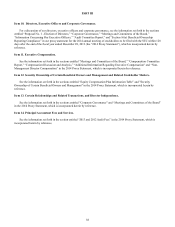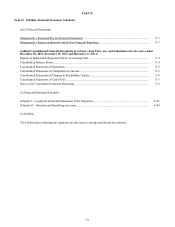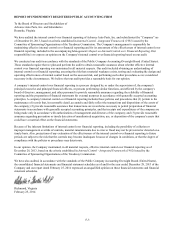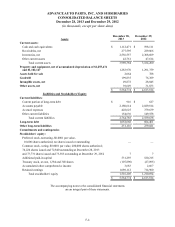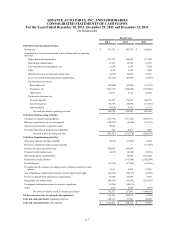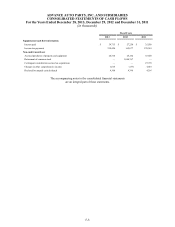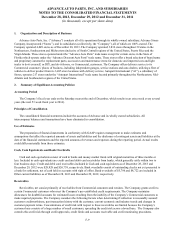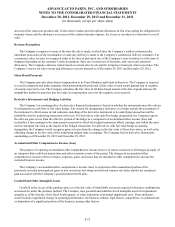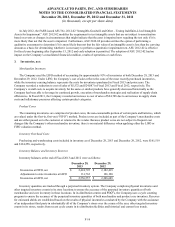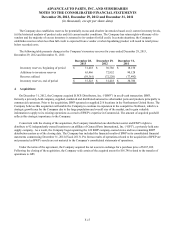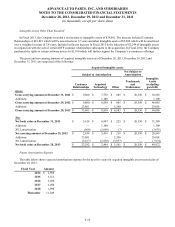Advance Auto Parts 2013 Annual Report Download - page 61
Download and view the complete annual report
Please find page 61 of the 2013 Advance Auto Parts annual report below. You can navigate through the pages in the report by either clicking on the pages listed below, or by using the keyword search tool below to find specific information within the annual report.ADVANCE AUTO PARTS, INC. AND SUBSIDIARIES
NOTES TO THE CONSOLIDATED FINANCIAL STATEMENTS
December 28, 2013, December 29, 2012 and December 31, 2011
(in thousands, except per share data)
F-9
1. Organization and Description of Business:
Advance Auto Parts, Inc. (“Advance”) conducts all of its operations through its wholly owned subsidiary, Advance Stores
Company, Incorporated (“Stores”), and its subsidiaries (collectively, the “Company”), all of which are 100% owned. The
Company operated 4,049 stores as of December 28, 2013. The Company operated 3,832 stores throughout 39 states in the
Northeastern, Southeastern and Midwestern (inclusive of South Central) regions of the United States, Puerto Rico and the
Virgin Islands. These stores operated under the “Advance Auto Parts” trade name except for certain stores in the State of
Florida which operate under the “Advance Discount Auto Parts” trade name. These stores offer a broad selection of brand name
and proprietary automotive replacement parts, accessories and maintenance items for domestic and imported cars and light
trucks to do-it-yourself, or DIY, and do-it-for-me, or Commercial, customers. The Company offers delivery service to its
Commercial customers’ places of business, including independent garages, service stations and auto dealers, utilizing a fleet of
vehicles to deliver product from its 3,485 store locations with delivery service. Autopart International (“AI”), a subsidiary of
Stores, operates 217 stores under the “Autopart International” trade name located primarily throughout the Northeastern, Mid-
Atlantic and Southeastern regions of the United States.
2. Summary of Significant Accounting Policies:
Accounting Period
The Company’s fiscal year ends on the Saturday nearest the end of December, which results in an extra week every several
years (the next 53 week fiscal year is 2014).
Principles of Consolidation
The consolidated financial statements include the accounts of Advance and its wholly owned subsidiaries. All
intercompany balances and transactions have been eliminated in consolidation.
Use of Estimates
The preparation of financial statements in conformity with GAAP requires management to make estimates and
assumptions that affect the reported amounts of assets and liabilities and the disclosure of contingent assets and liabilities at the
date of the financial statements and the reported amounts of revenues and expenses during the reporting period. Actual results
could differ materially from those estimates.
Cash, Cash Equivalents and Bank Overdrafts
Cash and cash equivalents consist of cash in banks and money market funds with original maturities of three months or
less. Included in cash equivalents are credit card and debit card receivables from banks, which generally settle within two to
four business days. Credit and debit card receivables included in Cash and cash equivalents as of December 28, 2013 and
December 29, 2012 were $28,828 and $26,738, respectively. Bank overdrafts consist of outstanding checks not yet presented to
a bank for settlement, net of cash held in accounts with right of offset. Bank overdrafts of $5,796 and $8,722 are included in
Other current liabilities as of December 28, 2013 and December 29, 2012, respectively.
Receivables
Receivables, net consist primarily of receivables from Commercial customers and vendors. The Company grants credit to
certain Commercial customers who meet the Company’s pre-established credit requirements. The Company maintains
allowances for doubtful accounts for estimated losses resulting from the inability of the Company’s Commercial customers to
make required payments. The Company considers the following factors when determining if collection is reasonably assured:
customer creditworthiness, past transaction history with the customer, current economic and industry trends and changes in
customer payment terms. Concentrations of credit risk with respect to these receivables are limited because the Company’s
customer base consists of a large number of small customers, spreading the credit risk across a broad base. The Company also
controls this credit risk through credit approvals, credit limits and accounts receivable and credit monitoring procedures.


